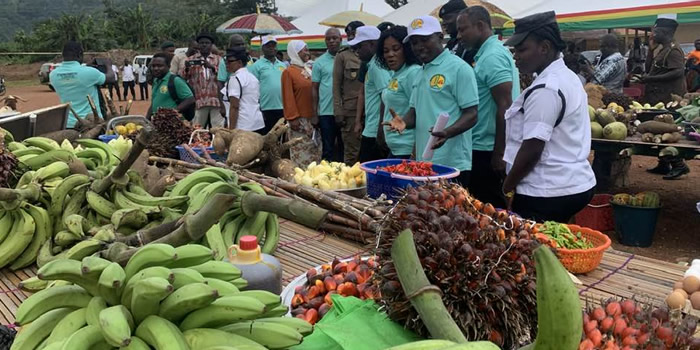

Agriculture
Agriculture and its related activities, ranks third in the order of economic activities in the Obuasi East district employing about 25% of the working population. Agriculture is predominantly on small basis in the district. About 90% of farm holdings are less than 2 hectares in size, although there are some large farms and plantations, particularly for citrus, oil palm and cocoa and to lesser extent maize, cassava, vegetables and pineapple. Major tree cash crops cultivated in the district is cocoa, citrus, oil palm and teak. Major food crops grown are cassava, maize, yam, rice and cocoyam. Vegetables like pepper, tomatoes, okra, cabbage and legumes are also cultivated in the district. Livestock production, especially pig farming, is fast gaining acceptance in the district. Other animals reared are sheep, goats and cattle. Agriculture is the dominant economic activity in terms of employment and income in Ghana. This is because improvement in agriculture has the potential to increase disposable income of the people which could lead to socio-economic transformation of the District. To achieve a sustainable development, it is very imperative that the industrial sector is improved to add value to the agricultural produce.
Agricultural Potentials in the district
Topography-wise the District can be demarcated into 3 agro-ecological zones for each of which specific agric-programmes could be prescribed.
Zone One
The Hills/ranges that stretch across the North-East and the South of the District are erosion prone terrains could be protected with economic woodlots and put under apiculture (Bee-Keeping). These two ventures wouldn’t require frequent visits to the steep sloped.
Zone Two
The well drained upper slopes/peaks of the widely undulating terrain are most suitable for the cultivation of economic tree crops namely cocoa, coffee, oil palm, citrus as well as staple foods such as plantain, banana, cassava, yams, vegetables, pineapple, cocoyam, maize, seed production, crop trials, etc.
Zone Three
Flood-prone valley bottom interacting with the undulating terrain of zone two would be most appropriate for the cultivation of rice, taro, sugar cane, development of agriculture (fish ponds) farming.
Table 1.27: Major Crops and Production levels 2014- 2017
Source: District Directorate of Agriculture- OEDA Sept. 2018
Effort in crop production over the years has seen significant improvement in the district. The table above depicts the crops production level and their annual increase rate from 2014 to 2016. From the table, there has been an increased in the various crops that are produce in the district.
Area under Cultivation
The table below shows the area under cultivation per the various major food crops in the district.
The table below shows the area under cultivation per the various major food crops in the district.
Source: District Directorate of Agriculture- OEDA Sept. 2018
The table above indicates the area under cultivation, taking into consideration the various crops that are produced in the district. There has been an increased in the land size for cultivation of all kinds of crops in the district. This to some extent creates an impression that giving the needed support to farmers in the district their commitment toward production of crops through intensive farming activities would be enhanced.
Cash Crop Production
The table below shows the area under cultivation per the various major cash crops in the district.
Table 1.29: Major cash Crops and Production levels, 2016
Source: District Directorate of Agriculture- OEDA Sept. 2018
It is therefore necessary for government to continuously support the programme to improve cocoa production in the district.
Source of Finance to Agriculture
Financing of agriculture in the district is mostly through personal savings. There are records from banks namely National Investment Banks and other Micro Financial institutions operating within the District but these institutions are not able to meet the financial needs of the farmers and somehow farmers are not also able to provide the needed collaterals security to attract loans to facilitate their farming activities.
Table 1.30: Sources of Finance for Farmers
Source: District Directorate of Agriculture- OEDA Sept. 2018
From Table 1.30, self-financing constitute the main source by which farmers in the District raise money to finance agricultural activities. This is followed by the family. The available financial institutions take the third position of sourcing the farmers in their activities. The reliance of farmers on their personal finances for their farming activities mean less money to buy inputs like agro chemicals, improved seedlings and the hiring of additional labour to expand their farm sizes and also increase yields.
Storage, Post-Harvest Losses and Marketing of Agriculture Produces
Storage has been one of the great challenges in the District. With the exception of cereals particularly maize and cowpea which are kept in cribs for a period of time, there is no modern and proper storage facilities for the crops produced especially foodstuffs. Farmers are compelled to offset their produce at lower prices which affect their income. Records from the District Agriculture department indicates that the mode of storage in the district includes bans, cribs and sacks.
Agric Extension Agents
The District has 4 Agricultural Extension Officers. The present extension officer-farmer ratio is 1: 2,500. Most of the farmers do not receive extension services because the extension officer-farmer ratio is low and this prevents the extension officer from reaching all the farmers in the district. Technological transfer is mainly done through home/farm visits, contact farmers, groups, demonstrations, field days and fora prominent among innovations transfer to farmers were weed control, using weedicide, control of black sikatoga on plantain using cultural practices, raw planting, use of improved varieties i.e. obatanpa maize, rapid yam and plantain multiplication fertilizer application and pest and diseases control.
Agric extension agent-farmer ratio in the District is presented in the Table below.
Table 1.31: Agric Extension Agent-Farmer Ratio
Source: District Directorate of Agriculture- OEDA Sept. 2018
More Agric Extension
Agents are therefore needed to provide technical expertise and know-how particularly in the fish and poultry subsectors. Logistics such as motor bikes and vehicles are therefore needed to be provided to the few available officers to improve their mobility.
Livestock and Poultry
Given the relatively high per capita income of the districts’ proximity to commercial towns of Kumasi, Dunkwa, Fosu, Cape Coast etc, vast markets for meat and poultry products pertain within the district and its immediate environs that needs to be exploited at all cost. Any massive investments in the two industries namely meat and poultry within the district would be a step in the right direction. Major setback in the industry is the scarcity of maize during the lean months (February–July). A possible solution could be the stocking of maize during the peak season in silos.
Table 1.32: Registered Poultry Farms in the District
Source: District Directorate of Agriculture- OEDA Sept, 2018
Table 1.32 depicts the level of commercialization of poultry in the District. This in no doubt has been a great source and form of job for the farmers themselves and the labourers employed. It also on the other hand serves as a source of manure for the crop and food stuff farmers in the District. Other livestock like goat, sheep among others are reared on home base level; owners do sell them from time to time to support their living.
Below is a table showing the number of stock in the District.
Table 1.33: Number of Other Livestock’s in the District
Source: District Directorate of Agriculture-OEDA Sept, 2018
Grass-Cutter Rearing
Snail Rearing
The district is on record as having one of the highest rainfall regimes in the entire Ashanti region. This provide an almost all the year humidity level congenial for snail rearing. Various leafy vegetables – kontomire, cassava pawpaw leaves, pawpaw fruits ‘alaifu’ and many staples foods suitable for snail feeding to support intensive snail rearing programmes. With the abundance of grasses in vast open spaces by road sides, besides several water bodies in the district, Grass-cutter rearing should be one of the non-traditional agricultural enterprise that should be accorded the highest priority in the district agriculture development programme.
Problems facing the agriculture sector in the district and the way forward
The agriculture subsector is confronted with the following problems:
- Low production/productivity:
Most of the operators in this sector heavily rely on the traditional and outmoded farming methods. Only a few percentage of farmers use modern improved farming technology due to most operators’ poor attitude to the improved methods of farming. The low production is also due to high cost of labour/inputs, land tenure system, over dependence on government for the supply of inputs and ageing farmers. - Over–dependence on rain-fed agriculture:
Agricultural activities in the district are tied to rainfall. The rainfall regime therefore affects the production levels. The unreliable rainfall distribution is a major cause of fluctuation in crop production. Added to this are the seasonal nature of rivers/streams and the high cost of irrigation equipment. - Limited Access to Credit:
Almost all the farmers in the district, especially food crop farmers, have no access to credit but depend on their own resources to operate. This causes the farmers to sell their crops to the market women who sometimes finance them at low prices immediately after harvest. The other sources of credit to the farmers include private moneylenders and financial institutions whose demands the farmers cannot afford. - Lack of Storage Facilities:
Storage facilities are not available in the district to store food crops after harvest resulting in high post-harvest losses which have negative impact on the economy. - Inadequate number of Agriculture Extension Agents (AEAs):
There are only 4 AEAs in the district meaning the extension officer–farmer ratio is 1: 2,500 compared to the national standard of 1:500. The inadequate number of AEAs adds to the farmers’ unwillingness to change. - High cost of Farming Inputs:
The low income levels of the farmers in this sector as a result of low production have prevented the farmers from being able to purchase farming inputs at high cost. - Pollution of Water Bodies:
Water bodies are being polluted by the use of chemicals especially by vegetable farmers.
Way forward for the Agriculture Sector
- Efforts are being made to bridge the AEA/Farmer Ratio gap.
- Farmers are encouraged to form groups to enable them access credit facilities from financial institutions.
- Provision of storage facilities
- Credit in kind to unemployed youth through the Block Farm system.
Commerce and Financial Services
The sector which falls into the informal sector employs about 40% of the working population in the district. A broad spectrum of economic and financial services exists in the district to facilitate business activities.
Food Security
The food security situation in the district is good. There is food all year round. The only threat to food security is the storage facilities and bushfires which often destroy the food crops and causes great damage during the dry season. A sound food security situation impacts positively on the development of the district. Although Obuasi East is noted for its mining activities, agricultural production in the rural communities is encouraging through the effort of the District Directorate of Agriculture and other stakeholders over the period. Obuasi East can boast of sufficiency in food supply especially cassava, plantain, cocoyam, maize and vegetables. However, a few food stuff such as rice, cowpea, yams are imported to supplement local sources due to their high demand.
The Department of Agriculture is currently undertaking a programme called the Planting for Food and Jobs. The campaign is designed to encourage all citizens (both urban and rural) to take up farming as a full or part-time activity. It is aimed at boosting food production in the country and creating jobs. The campaign will involve the production of maize, rice, soybean, sorghum and vegetables. The programme will be anchored on five pillars namely:
- provision of improved seeds;
- supply of fertilizers;
- provision of dedicated extension services;
- marketing and e-Agriculture and
- monitoring.
- Provide technical advice to farmers
Date Created : 6/1/2023 12:00:00 AM












 facebook
facebook
 twitter
twitter
 Youtube
Youtube
 +233 593 831 280
+233 593 831 280 0800 430 430
0800 430 430 GPS: GE-231-4383
GPS: GE-231-4383 info@ghanadistricts.com
info@ghanadistricts.com Box GP1044, Accra, Ghana
Box GP1044, Accra, Ghana